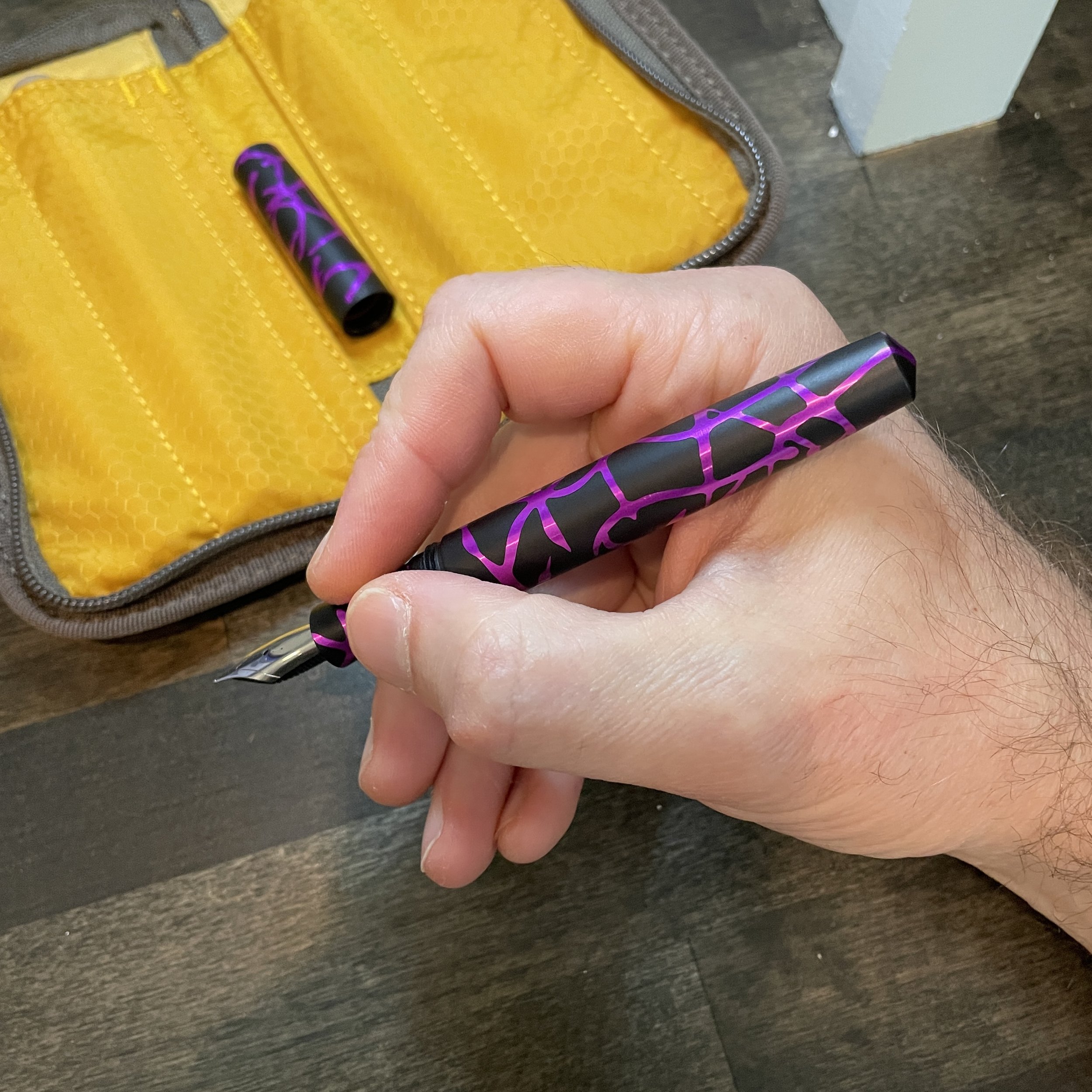If there’s any universal rule of pen shows, it’s that I’ll walk away from the Schon DSGN table with something(s) in my pocket. This year’s Chicago Pen Show was no exception. Literally 20 minutes into what was supposed to be an “I’m just here to look” show, I was at Ian’s table finalizing the purchase of a faceted “aged copper” Pocket Six fountain pen, and one of the new “Anniversary Edition” Machined Pens in Polished Bronze. What can I say? I can’t help myself.
A bit of a recap of the history of Schon DSGN is in order here. The company originally launched its first design - the “Machined Pen”, now the “Original Classic Machined Pen” - back in 2012. That pen defaulted to the Fisher Space Pen refill, which is an excellent option for write-anywhere pocket carry, and could also accept D1 refills using an adapter (sold separately). I have a couple of these Classic pens that I use regularly, including one in DLC-coated stainless steel and another in anodized aluminum. That said, Ian is rarely completely satisfied with any of his designs, and this year decided to offer a “redesigned” take on the Classic to celebrate more than a decade of high-quality writing instruments!
My Schon DSGN pocket pen collection, from left: the Classic Machined Pen in DLC stainless steel; the Classic Machined Pen v.2 in polished bronze, a Classic Machined Pen v1 in aluminum, a Pocket 6 fountain pen in faceted aged copper, and a Pocket 6 fountain pen in faceted brass.
So What’s Different?
Externally, there isn’t much of a difference at all between the “Classic v1” and the new “v2” or “Anniversary Edition.” The pen retains the same cylindrical shape, with a threaded end to allow you to post the cap securely for longer writing sessions. The pen, however, now unscrews from the grip section to refill, and the interior has been modified to accept a Parker-style refill cartridge, offering significantly more versatility with respect to refill options. The pen ships by default with the excellent Uniball Jetstream SXR-600-07 (.7mm tip size), a smooth, quick-drying writer that should please most people, though the Schmidt Easyflow 9000 is also available upon request.
But the refill swap isn’t the most exciting aspect of the new pen, at least to me. As part of the redesign, the Classic Machined Pen v2 is now fully compatible with Pocket Six fountain pen and rollerball sections, meaning that you can combine parts and switch how you use this pen depending on your needs. If you’d like to purchase a full kit outright, Schon DSGN sells the pen with all three section options, though the bronze shown here is currently available with the ballpoint grip only. (If you want to use a brass fountain pen section with the bronze, it still looks great!)
As you can see, there is very little, if any, differences between the grip section on the v1 (left) and the v2. If you enjoyed the first, you’ll almost certainly enjoy the second.
A Note on Material Choice
A huge reason why I love Schon DSGN metal pens, and especially the brass, bronze, and copper versions, is how they develop a patina over time. This particular pen features an aluminum bronze, which I find slightly warmer than brass and which takes on a somewhat unique tone as it ages. In the photo below, you’ll see the body (which has had significantly more hand/pocket contact than the section) has taken on a completely different tone. With the exception of sterling silver, I very rarely shine or polish any of my metal pens because I enjoy the weathered, “experienced” look.
Takeaways and Where to Buy
The Classic Machined Pen v2 is a solid standby that’s served as a core EDC item since I picked it up. The rock-solid clip holds firmly to either my shirt or pants pocket, and the Jetstream SXR-600 is a longtime favorite refill. What I can’t decide is whether to stick to the .7mm tip size (which will work fine for most people) or move to the .5mm or even the .38mm.
You can purchase the Schon DSGN Classic Machined Pen v2 directly from Schon DSGN, starting at $150 for the polished brass ballpoint, $160 for the polished copper, and $170 for the polished bronze. Purchasing the full set (ballpoint plus rollerball and fountain pen adapters) adds approximately $60 to your purchase. While not inexpensive, if you’re looking for that “one pen” (or “primary pen”) for your everyday carry, especially one that you can switch from ballpoint to roller to fountain, it’s a worthy consideration.
The Schon DSGN Classic Machined Pen (far left) closer to when I first acquired it. You can see from the more recent pictures how the polished bronze has aged. The pen is pictured here, from left, with a Kaweco Liliput, a Tactile Turn Titanium Gist, and a VERY well loved Rotring 800. (Only the Schon is mine - pen club pic.)
For further reading, you can check out my reviews of other Schon DSGN pens, such as the Pocket 6 fountain pen and the engineered plastics collection, by visiting our archive.
Disclaimer: This post does not contain paid advertising or affiliate links. I purchased this pen at the 2022 Chicago Pen Show with my own funds. If you enjoyed this review, consider supporting us directly via the T.G.S. Patreon Program and purchases from the T.G.S. Curated Shop, which this week is running a 10% off sale on all pencils and paper to thin out our inventory. Be sure to check it out! (Discount automatically applied at checkout.)


